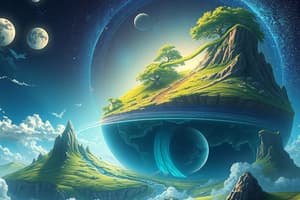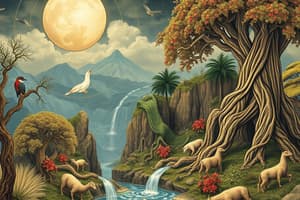Podcast
Questions and Answers
What subsystem refers to all the living organisms on Earth?
What subsystem refers to all the living organisms on Earth?
- Geosphere
- Biosphere (correct)
- Atmosphere
- Hydrosphere
Which subsystem is composed of Earth's crust and includes the inner layers of the Earth?
Which subsystem is composed of Earth's crust and includes the inner layers of the Earth?
- Atmosphere
- Biosphere
- Hydrosphere
- Geosphere (correct)
Which subsystem contains all the water found on Earth, regardless of its state of matter?
Which subsystem contains all the water found on Earth, regardless of its state of matter?
- Hydrosphere (correct)
- Biosphere
- Atmosphere
- Geosphere
Which subsystem includes the air on Earth and is formally known as the atmosphere?
Which subsystem includes the air on Earth and is formally known as the atmosphere?
What makes Earth unique in our solar system in terms of its subsystems?
What makes Earth unique in our solar system in terms of its subsystems?
Which sphere interacts with the biosphere by relying on the Earth's crust for shelter?
Which sphere interacts with the biosphere by relying on the Earth's crust for shelter?
What part of the geosphere is formed by the weathering of rocks and is essential for plant growth?
What part of the geosphere is formed by the weathering of rocks and is essential for plant growth?
Which process brings nutrients to the soil and involves the interaction between the atmosphere and the geosphere?
Which process brings nutrients to the soil and involves the interaction between the atmosphere and the geosphere?
What interacts to supply living organisms with water and air, as water vapor rises from one to form clouds and then releases rain?
What interacts to supply living organisms with water and air, as water vapor rises from one to form clouds and then releases rain?
What interaction is responsible for forming ocean waves, oxygenating the water, and absorbing carbon dioxide?
What interaction is responsible for forming ocean waves, oxygenating the water, and absorbing carbon dioxide?
Flashcards are hidden until you start studying
Study Notes
- The last sphere is called the atmosphere and consists of gases, water vapor, and clouds in the sky, extending from Earth's surface to over 6,200 miles high.
- Clouds are part of both atmosphere and hydrosphere as they form from water vapor in the atmosphere.
- Each sphere interacts with each other: atmosphere influences other spheres through weather, hydrosphere through storms and ocean tides, hydrosphere shapes terrain, geosphere influenced by volcanic eruptions, and biosphere influences the atmosphere by affecting climate.
- Weathering of rocks in the geosphere forms soil, which is a part of the geosphere, and is essential for plants to grow.
- Plants are part of the biosphere, which require water from the hydrosphere, air from the atmosphere, and soil from the geosphere to grow.
- Lava from volcanic eruptions, part of the geosphere, cools down in the atmosphere, solidifies, and brings nutrients to the soil.
- The atmosphere and hydrosphere interact to supply living organisms with water and air: water vapor rises from the hydrosphere to form clouds, then releases rain.
- Ocean waves are formed by the interaction of atmospheric winds and the hydrosphere, which oxygenate the water and absorb carbon dioxide.
- The biosphere interacts with the geosphere by relying on the Earth's crust for shelter, and groundwater is essential for plant growth and human consumption.
- Erupting volcanoes, part of the geosphere, can disrupt the biosphere by displacing or destroying habitats.
- The hydrosphere and atmosphere work together to influence the climate and geological processes, and support life on Earth.
- All spheres are interconnected, and the boundaries between them are not clearly defined.
- Many animals require resources from multiple spheres to survive: water from the hydrosphere, air from the atmosphere, and land from the geosphere.
- Plants absorb water from the soil, which is part of the geosphere, and require oxygen from the atmosphere to photosynthesize.
- Organic material, such as dead plants, is recycled in the soil and becomes part of the geosphere once it is consumed by microorganisms.
- Wind-driven ocean waves oxygenate the water, which is essential for aquatic life, and absorb carbon dioxide.
- The ocean absorbs carbon dioxide from the atmosphere, which is needed for the biosphere to continue to exist.
Studying That Suits You
Use AI to generate personalized quizzes and flashcards to suit your learning preferences.




